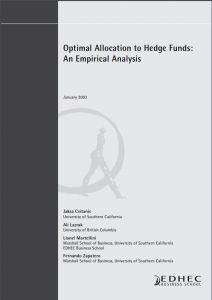

Optimal Allocation to Hedge Funds: An Empirical Analysis
What percentage of their portfolio should investors allocate to hedge funds? The only available answers to the above question are set in a static mean-variance framework, with no explicit accounting for uncertainty on the active manager’s ability to generate abnormal return, and usually generate unreasonably high allocations to hedge funds. In this paper, we apply the model introduced in Cvitanic, Lazrak, Martellini and Zapatero (2002) for optimal investment strategies in the presence of uncertain abnormal returns to a database of hedge funds. Wefind that the presence of model risk significantly decreases an investor’s optimal allocation to hedge funds. Another finding of this paper is that low beta hedge funds may serve as natural substitutes for a significant portion of an investor risk-free asset holdings. A revisited version of this paper was published in the February 2003 issue of Quantitative Finance.
Author(s):
Summary:
What percentage of their portfolio should investors allocate to hedge funds? The only available answers to the above question are set in a static mean-variance framework, with no explicit accounting for uncertainty on the active manager’s ability to generate abnormal return, and usually generate unreasonably high allocations to hedge funds. In this paper, we apply the model introduced in Cvitanic, Lazrak, Martellini and Zapatero (2002) for optimal investment strategies in the presence of uncertain abnormal returns to a database of hedge funds. Wefind that the presence of model risk significantly decreases an investor’s optimal allocation to hedge funds. Another finding of this paper is that low beta hedge funds may serve as natural substitutes for a significant portion of an investor risk-free asset holdings. A revisited version of this paper was published in the February 2003 issue of Quantitative Finance.
Register to download PDF
Register/Log in| Type : | Working paper |
|---|---|
| Date : | 23/01/2003 |
| Keywords : |
Asset Allocation |

